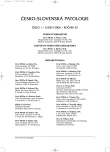Histologic Findings in Subantral Augmentation (Sinus Lift)
Authors:
A. Kohout 1; A. Šimůnek 2; D. Kopecká 2
Authors‘ workplace:
Fingerlandův ústav patologie LF UK a FN, Hradec Králové
1; Stomatologická klinika, FN a LF UK, Hradec Králové
2
Published in:
Čes.-slov. Patol., 42, 2006, No. 1, p. 29-33
Category:
Overview
Subantral augmentation (sinus lift) is used to increase alveolar bone mass of lateral maxilla in order to insert dental implants. In addition to the autogenous bone several foreign materials can be used for augmentation and they can replace the autogenous bone to some extent. Histological findings in specimens taken nine months after augmentation with the autogenous bone, deproteinised bovine bone (Bio-Oss) and beta-tricalcium phosphate (Cerasorb) are presented. In all cases a new bone formation around the augmentation material was seen. The new bone was deposited predominantly on its surface. In cases with Cerasorb the new bone formation was observed within the porous granules, too. From the obtained results it can be concluded, that the main osteogenetic mechanism in the examined augmentation materials was osteoconduction. The biocompatibility of the used augmentation materials was evidenced by an absence of giant cell granulomatous reaction and of marked inflammatory infiltrate.
Key words:
sinus lift – histology – new bone formation – autogenous bone – deproteinized bovine bone – Bio-Oss – beta-tricalcium phosphate – Cerasorb
Labels
Anatomical pathology Forensic medical examiner ToxicologyArticle was published in
Czecho-Slovak Pathology

2006 Issue 1
Most read in this issue
- Cervical Cancer Precursors: Cytohistologic Correlation with the Results of HPV Testing
- Pyloric Gland Adenoma – How to Diagnose?
- Isolated Lymphadenopathy as the First Presentation of Systemic Mastocytosis – Description of Two Cases
- Malignant Fibrous Histiocytoma of the Breast: Report of Two Cases
